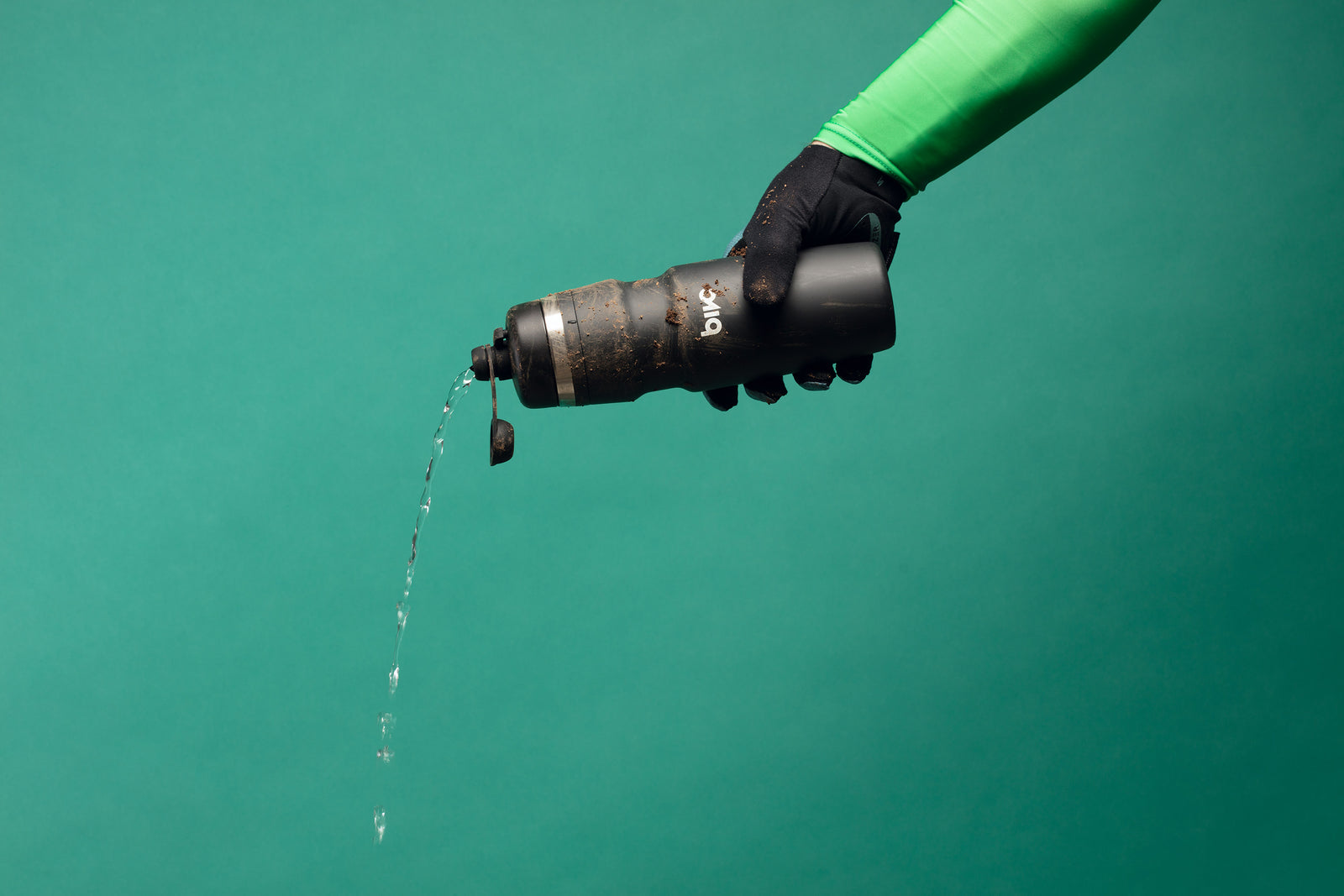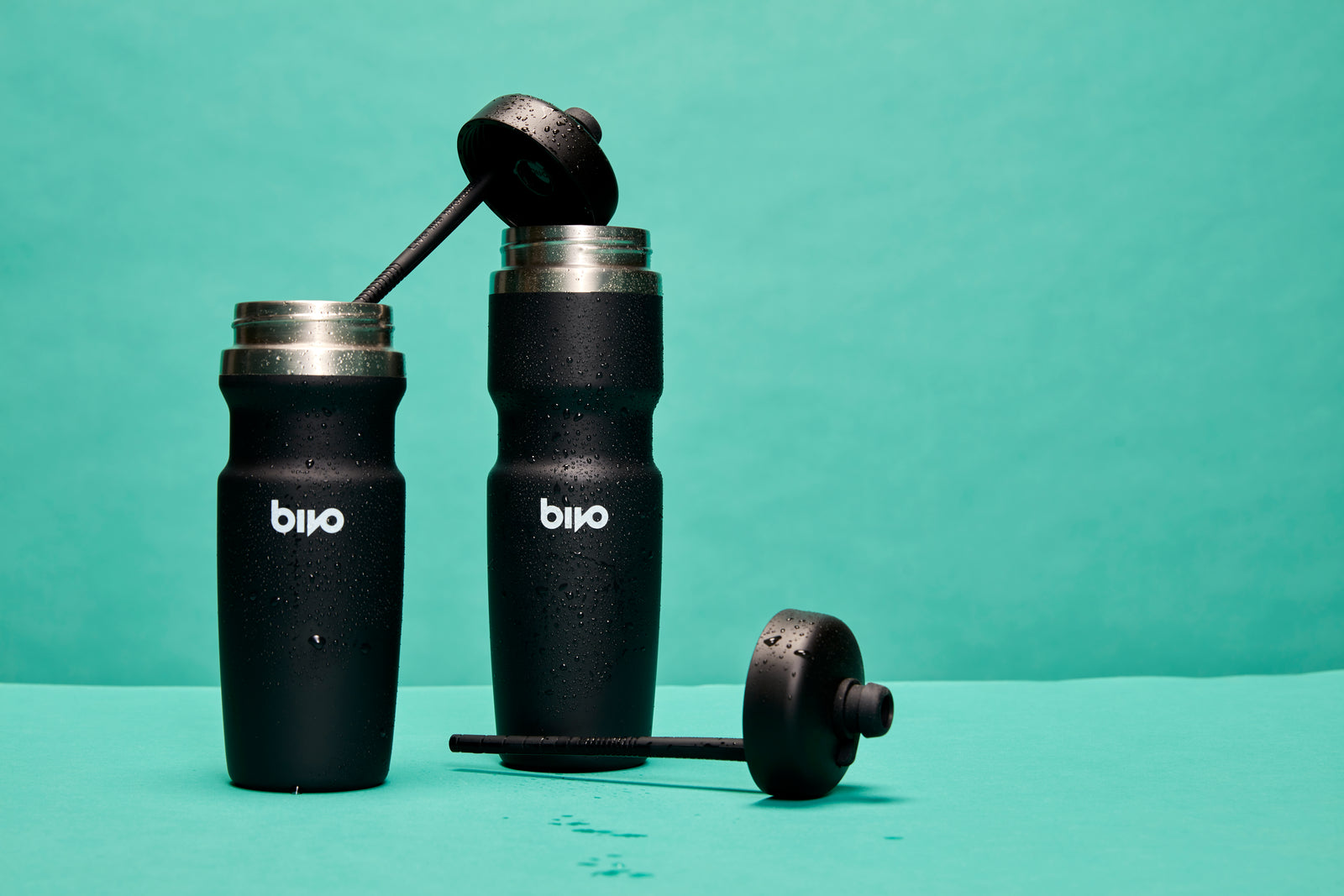Thank you for this article (and a great product). This is a real eye opener and something I honestly hadn’t even thought about. Keep up the amazing things you are doing….
November 7th, 2024 | by Robby Ringer
Lately, there’s been a lot of media coverage—and plenty of conversation here at our office—about the alarming levels of harmful chemicals found in cheap, recycled black plastics, all prompted by a recent study. It’s scary. And awful that so many products we use daily, eat from, or even let our kids play with could be exposing us to these chemicals.
Before we dig in, let me assure you: Bivo bottles and the plastic in our lids have undergone extensive testing to meet the most stringent chemical safety standards. Our bottles are 100% free of the chemicals mentioned in the study- such as brominated flame retardants (BFRs), organophosphate flame retardants (OPFRs), and heavy metals such as cadmium, chromium and lead.
Lately, there’s been a lot of media coverage—and plenty of conversation here at our office—about the alarming levels of harmful chemicals found in cheap, recycled black plastics, all prompted by a recent study. It’s scary. And awful that so many products we use daily, eat from, or even let our kids play with could be exposing us to these chemicals.
Before we dig in, let me assure you: Bivo bottles and the plastic in our lids have undergone extensive testing to meet the most stringent chemical safety standards. Our bottles are 100% free of the chemicals mentioned in the study- such as brominated flame retardants (BFRs), organophosphate flame retardants (OPFRs), and heavy metals such as cadmium, chromium and lead.
Photo credit to Joshua Strong!
Photo credit to Joshua Strong!
Our standards go beyond the U.S. FDA requirements, also meeting strict European safety standards, including REACH and LFGB. We follow these European standards because, frankly, we believe FDA guidelines alone don’t push the industry far enough. Specifically, all our bottle components meet FDA and European REACH standards, and they’re certified to be free of BPA, BPS, BPF, and PFAS. In short, we go the extra mile to ensure that the materials in every Bivo product meet the highest safety benchmarks.
As a parent, this issue hits home for me. Reading about the dangers of certain plastics has definitely changed the way Carina and I approach everyday items in our household. Just a few weeks ago, Carina and I both saw this article on black plastic, looked at each other, and then agreed without words that last night’s take-out leftovers in black plastic containers were going straight to the trash. We’re rethinking and adjusting all the time—researching plastics here at Bivo has only reinforced that. We’ve swapped out plastic food containers for glass, we cook with cast iron instead of non-stick, and we use glass, metal, or wooden bowls for food prep. Recently, we even gave up plastic wrap (yes, that was a hard one!).
As consumers, putting in the work means doing just what you’ve done by reaching out to us with questions: asking brands about their safety standards. If you’re ever unsure, reach out to them directly. And if they’re vague or don’t respond, that’s a signal to reconsider. This is especially important for food-related products or anything kids are likely to handle or put in their mouth.
Our standards go beyond the U.S. FDA requirements, also meeting strict European safety standards, including REACH and LFGB. We follow these European standards because, frankly, we believe FDA guidelines alone don’t push the industry far enough. Specifically, all our bottle components meet FDA and European REACH standards, and they’re certified to be free of BPA, BPS, BPF, and PFAS. In short, we go the extra mile to ensure that the materials in every Bivo product meet the highest safety benchmarks.
As a parent, this issue hits home for me. Reading about the dangers of certain plastics has definitely changed the way Carina and I approach everyday items in our household. Just a few weeks ago, Carina and I both saw this article on black plastic, looked at each other, and then agreed without words that last night’s take-out leftovers in black plastic containers were going straight to the trash. We’re rethinking and adjusting all the time—researching plastics here at Bivo has only reinforced that. We’ve swapped out plastic food containers for glass, we cook with cast iron instead of non-stick, and we use glass, metal, or wooden bowls for food prep. Recently, we even gave up plastic wrap (yes, that was a hard one!).
As consumers, putting in the work means doing just what you’ve done by reaching out to us with questions: asking brands about their safety standards. If you’re ever unsure, reach out to them directly. And if they’re vague or don’t respond, that’s a signal to reconsider. This is especially important for food-related products or anything kids are likely to handle or put in their mouth.
Finally, we wanted to answer a few key questions from our team to help guide you toward making safe choices.
Not all black plastic is inherently dangerous. The real issue lies in recycled black plastic, commonly used in items like sushi trays, to-go containers, and kitchen utensils. I highly recommend checking out the article Why Black Plastic is Bad News by Beyond Plastics. They explain how only about 15% of plastic recyclables are black, which falls far short of industry demand. To compensate, manufacturers sometimes mix e-waste, like discarded electronics, into virgin plastic.
Even more concerning, as Beyond Plastics points out, there are currently no government regulations that specifically address the safety of recycled black plastic products. That’s a scary reality, and it’s a major reason why chemical testing should be a standard we demand from all brands. It’s essential to know that the products we use daily, especially those in contact with food, are safe.
Great question! The answer is simple: we use only high-quality plastic that undergoes rigorous testing to meet—and exceed—both FDA (U.S. standards) and REACH (stricter European standards) requirements. We run these tests regularly and any time a new material enters our supply chain. Our products have always surpassed these standards, and we’re committed to ensuring they continue to do so in the future. Unlike the black plastic referenced in these studies and news articles, Bivo’s plastic (both colorful and black) does not have any of the toxic chemicals referenced. Our plastic is also free of many other harmful chemicals that weren’t the focus of these articles (see below for more details on this!)
Honestly, I wish I had a good answer for this—it’s a question that frustrates many of us. Without regulations in place, brands have to take on the responsibility themselves. My suggestion? Look into the testing practices of the brands you trust. Don’t hesitate to ask them directly about their chemical testing processes. Until regulations catch up, it’s up to us as consumers to ask how companies are ensuring the safety of the products we bring into our lives.
Finally, we wanted to answer a few key questions from our team to help guide you toward making safe choices.
Not all black plastic is inherently dangerous. The real issue lies in recycled black plastic, commonly used in items like sushi trays, to-go containers, and kitchen utensils. I highly recommend checking out the article Why Black Plastic is Bad News by Beyond Plastics. They explain how only about 15% of plastic recyclables are black, which falls far short of industry demand. To compensate, manufacturers sometimes mix e-waste, like discarded electronics, into virgin plastic.
Even more concerning, as Beyond Plastics points out, there are currently no government regulations that specifically address the safety of recycled black plastic products. That’s a scary reality, and it’s a major reason why chemical testing should be a standard we demand from all brands. It’s essential to know that the products we use daily, especially those in contact with food, are safe.
Great question! The answer is simple: we use only high-quality plastic that undergoes rigorous testing to meet—and exceed—both FDA (U.S. standards) and REACH (stricter European standards) requirements. We run these tests regularly and any time a new material enters our supply chain. Our products have always surpassed these standards, and we’re committed to ensuring they continue to do so in the future. Unlike the black plastic referenced in these studies and news articles, Bivo’s plastic (both colorful and black) does not have any of the toxic chemicals referenced. Our plastic is also free of many other harmful chemicals that weren’t the focus of these articles (see below for more details on this!)
Honestly, I wish I had a good answer for this—it’s a question that frustrates many of us. Without regulations in place, brands have to take on the responsibility themselves. My suggestion? Look into the testing practices of the brands you trust. Don’t hesitate to ask them directly about their chemical testing processes. Until regulations catch up, it’s up to us as consumers to ask how companies are ensuring the safety of the products we bring into our lives.
To wrap things up, I just want to say thank you again for reaching out, being curious, and placing your trust in us and the products we offer.
If you ever have any questions—whether they’re related to Bivo’s chemical testing policy or anything else—I’m always here and happy to help however I can. The world of chemical testing can be overwhelming and, honestly, a bit scary. Carina summed it up perfectly in her article Lead and Bivo’s Chemical Testing Policy when she said, “Chemical testing has always been a bit baffling to me. It’s too easy to sneak by and do the bare minimum, or find loopholes that allow bad things on products we use in our daily lives.” Reach out anytime: thirsty@drinkbivo.com
Thank you all,
Robby
To wrap things up, I just want to say thank you again for reaching out, being curious, and placing your trust in us and the products we offer.
If you ever have any questions—whether they’re related to Bivo’s chemical testing policy or anything else—I’m always here and happy to help however I can. The world of chemical testing can be overwhelming and, honestly, a bit scary. Carina summed it up perfectly in her article Lead and Bivo’s Chemical Testing Policy when she said, “Chemical testing has always been a bit baffling to me. It’s too easy to sneak by and do the bare minimum, or find loopholes that allow bad things on products we use in our daily lives.” Reach out anytime: thirsty@drinkbivo.com
Thank you all,
Robby


Keaton Smith
November 11, 2024
Hi Scott – Totally understand the desire to completely remove plastic from our lids. This was something we researched heavily in the initial engineering phase. Unfortunately, metal manufacturing techniques are not commercially viable to create a sport nozzle lid. That being said, there are avenues we are taking to come out with lids that reduce plastic even further. Also, we have big hopes someday that metal 3D printing could become the commercially viable solution for exactly what you are talking about. Rest assured we are eager to figure this out too! Thanks for asking about this!